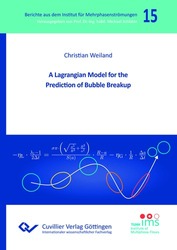| Departments | |
|---|---|
| Book Series (96) |
1378
|
| Nachhaltigkeit |
3
|
| Gesundheitswesen |
1
|
| Humanities |
2362
|
| Natural Sciences |
5406
|
| Engineering |
1790
|
| Engineering | 291 |
| Mechanical and process engineering | 861 |
| Electrical engineering | 686 |
| Mining and metallurgy | 30 |
| Architecture and civil engineering | 75 |
| Common |
97
|
|
Leitlinien Unfallchirurgie
5. Auflage bestellen |
|
Advanced Search
A Lagrangian Model for the Prediction of Bubble Breakup (Volume 15) (English shop)
Christian Weiland (Author)Preview
Extract, PDF (200 KB)
Table of Contents, PDF (82 KB)
In many chemical and biochemical processes, mass transfer between gas and liquid phases plays a crucial role. Gaseous species are often introduced into the system as bubbles, with mass transfer occurring at the bubble surfaces. Processes such as bubble breakup and coalescence significantly affect the total surface area and, consequently, the mass transfer rate. Other influencing factors include boundary layer thickness and local concentration gradients, which drive the transfer through differences in chemical potential.
This work focuses on the development, implementation, and validation of a new model to describe gaseous bubble breakup. A trajectory-based approach is used, modeling each bubble individually as a Kelvin-Voigt element, and assuming that bubbles behave like rotating ellipsoids. Surface tension is represented as a theoretical spring pulling the bubble toward its equilibrium (spherical) shape, while gas viscosity is modeled as a damper resisting deformation. The deformation itself is described using a Lagrangian analysis of the local fluid-induced stretching.
Bubble breakup is determined by comparing the surface tension force, reduced by deformation, to inertial forces such as drag. Initially, drag is approximated by buoyancy, but this simplification ignores varying flow conditions. Therefore, a more accurate drag force formulation is derived to improve the model.
Both model versions are tested using Lattice Boltzmann simulations. The resulting bubble sizes are used to calculate mass transfer via either penetration theory or a Sherwood correlation, and the results are validated against experimental data.
In vielen chemischen und biochemischen Prozessen spielt der Stoffübergang zwischen Gas- und Flüssigphase eine zentrale Rolle. Gasförmige Stoffe gelangen dabei meist in Form von Blasen ins System, wobei der Stofftransport an deren Oberfläche erfolgt. Prozesse wie Blasenzerfall (Breakup) und Koaleszenz beeinflussen die Gesamtoberfläche und damit den Stoffübergang maßgeblich. Weitere Einflussfaktoren sind Konzentrationsunterschiede und Grenzschichtdicken, die den chemischen Potentialunterschied – den Antrieb des Stofftransfers – bestimmen.
In der vorliegenden Arbeit wird ein neues Modell zur Beschreibung des Blasenzerfalls entwickelt, implementiert und validiert. Das Modell basiert auf einer trajektorienbasierten Methode, bei der jede Blase als Kelvin-Voigt-Element individuell betrachtet wird und sich wie ein rotierendes Ellipsoid verhält. Die Oberflächenspannung wirkt als theoretische Feder, die die Blase in ihre Gleichgewichtsform (eine Kugel) zurückführt, während die Viskosität des Gases durch einen Dämpfer modelliert wird. Die Deformation wird mittels einer Lagrange-Analyse beschrieben.
Der Blasenzerfall wird durch den Vergleich von Oberflächenspannung und Trägheitskräften (z. B. Auftrieb) bestimmt. Anfangs wird die Trägheitskraft vereinfacht durch den Auftrieb angenähert, was jedoch eine Schwäche des Modells darstellt, da dies keine Berücksichtigung der Strömungsbedingungen erlaubt. Daher wird eine präzisere Formulierung der Widerstandskraft (drag force) entwickelt.
Beide Modellvarianten werden mittels Lattice-Boltzmann-Simulationen getestet. Der resultierende Stoffübergang wird mit Hilfe der Penetrationstheorie oder einer Sherwood-Korrelation berechnet und mit experimentellen Daten validiert.
| ISBN-13 (Hard Copy) | 9783689523503 |
| ISBN-13 (eBook) | 9783689523510 |
| Final Book Format | B5 |
| Language | English |
| Page Number | 126 |
| Lamination of Cover | matt |
| Edition | 1. |
| Book Series | Berichte aus dem Institut für Mehrphasenströmungen |
| Volume | 15 |
| Publication Place | Göttingen |
| Place of Dissertation | TU Hamburg |
| Publication Date | 2025-09-11 |
| General Categorization | Dissertation |
| Departments |
Engineering
Allgemeine Verfahrenstechnik |
| Keywords | Multiphase flows, Bubble breakup, Trajectory-based methods, Computational fluid dynamics, Bubble size distribution, Mass transfer, Mehrphasenströmungen, Blasenzerfall, Trajektorienbasierte Methoden, Numerische Strömungsmechanik, Blasengrößenverteilung, Stofftransport |








